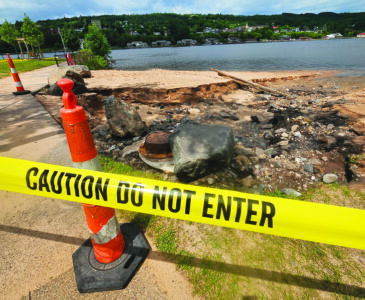Buffalo Reef task force presents options to locals

Map by Department of Natural Resources A task force is weighing options for dealing with stamp sands near the Buffalo Reef near the Grand Traverse Harbor. The migration of stamp sands from Gay has covered large portions of the reef, which are a main spawning grounds for whitefish in the Keweenaw.
LAKE LINDEN — Members of a task force charged with finding ways to protect Buffalo Reef from encroaching stamp sands presented ideas to the public at an informational meeting in Lake Linden Wednesday night.
About 15 million cubic yards of stamp sand deposited at the Gay Mill are migrating across the channel to Schoolcraft Township.
The reef and surrounding habitat account for a third of lake trout and 8.5% of whitefish spawning habitat in the U.S. portion of Lake Superior, according to the Department of Natural Resources. It could also choke off access to Grand Traverse Harbor, a popular recreational harbor southwest of the reef.
The total value of the fishery is estimated at $4.7 million.
The group proposed three main solutions: maintenance dredging at Grand Traverse Harbor and an underwater trough, with a stone revetment to block the dredged sands from returning; dredging everything with disposal in a newly constructed nearby; and dredge everything and put it in the White Pine tailing basin.
The maintenance dredging is the least expensive, at about $279 million, according to rough estimates from the group. The landfill option costs about $387 million; costliest is the White Pine disposal, at about $584 million. The estimates are “very preliminary,” with a margin of error of plus or minus 50 percent, the group said.
In the first option, the 10,000-foot revetment would start in Gay and extend nearly to the coal dock area. That would block about 5 million tons (3 million cubic yards), which would save dredging costs, said Steve Casey, a contractor with the project.
The sands would be segregated by grain size to enable future beneficial use. Dredging could take place at once, or over decades, Casey said. Removing all of it in a matter of years would be expensive, and unlikely, said Steve Check, project manager with the U.S. Army Corps of Engineers.
“That’s one of the things the feasibility study, as we move forward, is going to look at and work through, is look at these different scenarios and figure out the cost-benefit ratio,” he said.
A hydrodynamics model done by the U.S. Army Corps of Engineers showed 10 years of dredging and revetment would be able to save Buffalo Reef, said Michigan technological University professor Charles Kerfoot. In the same time frame, 60% of the reef would be covered with no action.
In the landfill option, the stamp sands would be moved uplands to a location about a mile away from Lake Superior. The landfill would be lined with a clay or synthetic liner to prevent leachate from infiltrating water; the leachate would also need to be treated, Casey said. Stamp sands would likely be taken from the lakefront to a placement area by hydraulics or a conveyer belt.
It would be about 150 acres and 100 feet high, Casey said.
“It’d be a very significant pile of material, but that’s what we’re dealing with,” Casey said.
The third option would involve moving the material to the former White Pine Mine tailings basin. The pile would be about 150 acres and 100 feet high, Casey said.
Since the area is already impacted, the environmental impact will be lesser. However, transportation costs would be highest of the three, involving transporting it by boat from Gay and conveying it about two miles through the woods from Silver City.
“Probably the most environmentally sound ones are the most expensive ones,” Casey said.
The task force, formed in 2017, considered a number of alternatives, such as deep water disposal and building a new roof. In June, they narrowed their preferred list to three. Casey outlined flaws of some of the alternatives. For instance, disposal into 100-foot-deep waters had been premised on it not being an ecologically rich region. Additional research found the site had abundant fish and other life.
“All we’d be doing is moving the problem from one site to another,” he said.
Detailed analysis of the options is expected to begin this fall.




